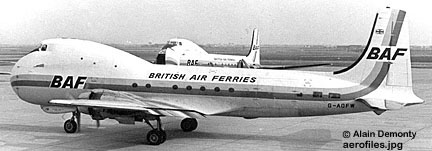

Car via Air
The name said it all—an aircraft to ferry automobiles across the channel. In accomplishing this deed, the Carvair ATL-98 began with a Douglas C-54/DC-4 and a major facelift on the forward one-third.



Ostensibly a long, hollow tube in which to carry oversize cargo—the planes would accept more than 18,000 pounds of goods through their hinged nose—influence by Aero Spacelines' Guppy series was apparent, but the concept and design of a separate, topside flight deck was novel, and would soon appear in the Boeing 747.

I have the Air-Britain 1967 publication on the Douglas DC-4—including Canadair 4 and Douglas DC-5—compiled by Berry, Dunstall, Ford, and Whittle. From June 1961 through Oct 1965, Aviation Traders Ltd, a British company, as your other correspondents had noted, converted 20 C-54/DC-4s to the Carvairs. They could hold up to 6 cars (typical British-sized, I guess) and 22 passengers for the Channel hop and other short hauls to avoid long boat rides. ATL converted what was brought them, with 18 being various models originally delivered as varieties of C-54s and two DC-4-1009s being built for the civilian market. The publication gives brief histories of all the owners, registrations, and dispositions to that time of all C-54s, DC-4s, DC-5s, and Carvair ATL-98s—a serious effort to utilize excellent airframes for an imaginative application. (— Jack Erickson (12/22/01)



Aviation Traders developed the Carvair in response to Channel Air Bridge's requirement for an air ferry capable of transporting passengers and their cars between the United Kingdom and continental Europe.

Although its external appearance is quite different, the Carvair was a
conversion of the Douglas DC-4 airliner or military C-54 Skymaster, large numbers of which were available after WW2. Airframe from the wings rearward was a standard DC-4, except for a lengthened vertical tail for enhanced controllability. Major modifications on the forward fuselage centred on a new, lengthened nose section with a hydraulically operated cargo door which allowed nose loading for cars, and an elevated flight deck.

First flight of the Carvair conversion was 6/2/61, and they entered service with British United Air Ferries, with which Channel Air Bridge had merged—it later became British Air Ferries and is now British World Airways) in March 1962. Deliveries to other operators included three for Aer Lingus (Ireland) and two for Aviaco of Spain. Others were operated by carriers in Australia, France, and Luxembourg.

Aviation Traders also proposed a Carvair type conversion of DC-6, DC-6B, and DC-7 with the option of Rolls-Royce Dart turboprops, although those plans were never carried through.

In 1998 one Carvair was operated by Hawkair Aviation in British Columbia,
Canada [C-GAAH]. Another operated from Bear Creek/Tara Field in
Georgia and a third was stored in South Africa. All were former Ansett planes. (Aerospace Publications)

North American Registrations:
|

